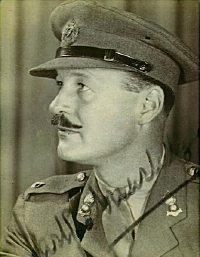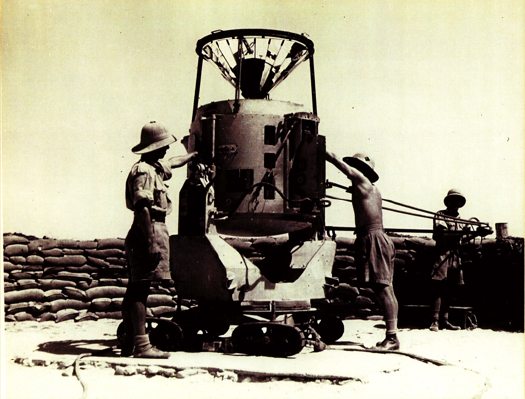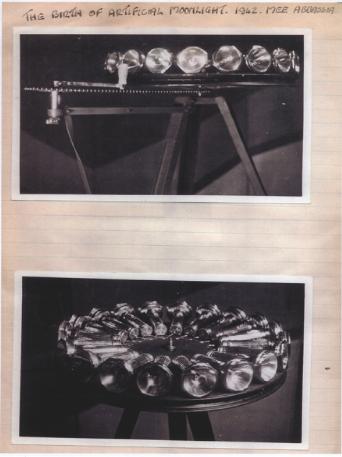 Sure, there's Dutch Camo Landscapes, and Razzle Dazzle, and the Civilian Camouflage Council, but it all pales in comparison to the truly epic WWII camo accomplishments of Jasper Maskelyne and The Magic Gang.
Sure, there's Dutch Camo Landscapes, and Razzle Dazzle, and the Civilian Camouflage Council, but it all pales in comparison to the truly epic WWII camo accomplishments of Jasper Maskelyne and The Magic Gang.
Maskelyne was a British magician-turned-Army camo mastermind who, in 1941, led a ragtag band of desert artists and illusionists who created a series of incredible camo techniques that protected Allied forces in North Africa from aerial reconnaissance and bombardment.
Using burlap and sticks, they disguised trucks as tanks, and tanks as trucks, and they created devices to enable tanks to cover their own tracks across the desert sands. But the most amazing achievements are in his 1949 memoirs, Magic - Top Secret where Maskelyne--whose grandfather, also a magician, invented the pay toilet--tells how he saved the port of Alexandria, Egypt from night bombing by building an elaborately lit decoy port, several miles away in the desert. Using incendiary devices and real anti-aircraft artillery, he and his Magic Gang fooled the German bombers with realistic-looking "hits" and return fire; and by morning, his crews would strew papier-mache rubble around the real port, giving simulated damage for the reconn pilots to report back. [below: a German spy photo of part of the port]

The success of the Alexandria decoy was only surpassed by Maskelyne's brilliant [literally] strategy for protecting a vital supply route for the Allies, the Suez Canal. He designed "Dazzle Lights," a rotating structure of made up of mirrors and 24 powerful anti-aircraft searchlights that, when set into motion, gave off a "Whirling Spray,":
[Maskelyne] managed to create beams nine miles long, twenty-four of them from each searchlights [sic] ... the magic mirrors were a success, and the next job was to get the device into mass production. With them, we made twenty-one searchlights serve for the entire one-hundred-mile length of the Suez Canal.That's right, the Suez Canal was saved from being bombed by the biggest lightshow in history: the 100-mile-long, Whirling Spray of almost two dozen Dazzle Lights.
How is it possible that I did not know this before now? Why is this miracle of modern warfare not taught in our military academies? Our elementary schools, even? How are these mindblowing aesthetic achievements not celebrated as a landmark in the history of art? Why is there no Bruckheimer movie, starring Josh Hartnett as the daring soldier magician? Maybe because the entire thing is bullshit.
In 2004, military historian and magician [seriously] Richard Stokes published the findings of his multi-year investigation into Maskelyne's claims. They are gathered in the exhaustively paged website, MaskelyneMagic.com. Working with the magician's son, he had access to Maskelyne's archives and scrapbooks from the war. Stokes also cross-referenced official records, declassified intelligence reports, and consulted experts and historians in the North African war. And there is nothing in the historical record to support Maskelyne's fantastical claims.
On Alexandria, the place where he said he built a decoy port doesn't even exist; neither does the geography he describe match to any in the vicinity of the city. There are no pictures or corroborating eyewitness accounts, and no documentation.
On the Suez front, Stokes demolishes Maskelyne's claim to have invented Dazzle Lights by pointing to similar, tank-based tactics under development since WWI. Again, no record of Dazzle Lights can be found in the historical source material, and extensive accounts of the actual defense of the Canal provide well-documented alternative explanations to Maskelyne's. According to Stokes, Maskelyne didn't actually come up with the Whirling Spray idea until 1942, after the aerial threat had subsided. And he quotes the illusionist's son: "The 'Dazzle Lights' were an idea which was, I believe, constructed only in one prototype and tested on one occasion."
Which appears to be the scene depicted in the photo gallery on Stokes' site, where a searchlight is being outfitted with a faceted, mirrored cone extension:

Which means the photo below, showing an awesomely Duchampian folly, 18 flashlights on a turntable, is somewhat confusing to me:

But with a caption like, "The birth of artificial moonlight, 1942," I'd think that Maskelyne's imagined heroics are long overdue for [re-]creation.
The War Magician| ""Myth is invulnerable to mere facts" - Barthes [all images via MaskelyneMagic.com]
Previously: Bombardment Periphery, Rotterdam, and Los Angeles's 'wigwam' of searchlights; Forrest Myers' light pyramid












